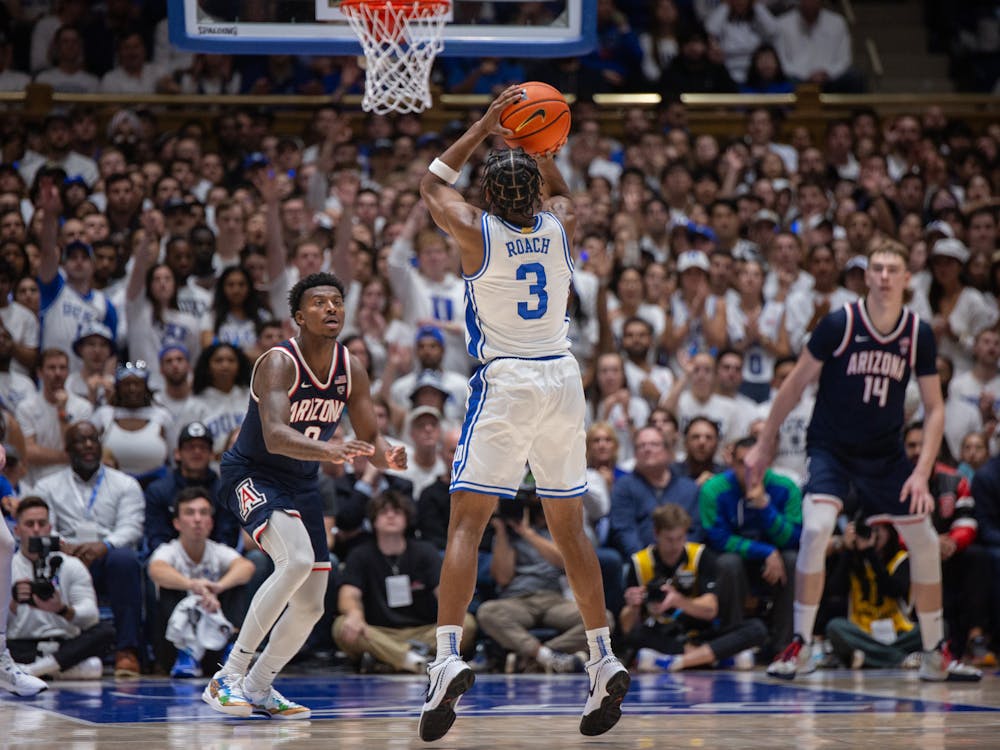Aside from the preseason narrative surrounding the guard room and recruiting, sophomore captain Tyrese Proctor walked onto Coach K Court Nov. 1 and inserted an idea into everyone’s heads: Duke is a shooting team. In the exhibition matchup against UNC Pembroke, the first public Blue Devil play against an external opponent, Proctor made four 3-pointers in less than three minutes.
With the loss of its defensive star, the 7-foot-1 behemoth of a shot-blocker that was Dereck Lively II, all eyes turned to Duke’s offense, and the potential that it could have this season. A three-guard lineup of lethal 3-point shooters sounded (and still does sound) enticing. And from the tip against the Braves, it seemed probable.
In the team’s 78-73 loss against Arizona, especially in the first half, the Blue Devil guards fell cold. Duke was 2-for-12 from three in the opening period, with one of those makes coming at the hands of 7-foot center Kyle Filipowski. Proctor missed all four of his attempts. Senior Jeremy Roach’s lone shot didn’t fall, and in freshman Caleb Foster’s nearly nine minutes on the court, he didn’t take a single shot from anywhere.
Sixteen of the Blue Devils’ 33 first-half points came from the paint, six from outside the arc, five from the line. Not a single one was off a rebound on a second-chance attempt. The small-ball, guard-heavy lineup was forced out of its comfort zone, and it fell behind.
“We didn’t play Duke basketball,” head coach Jon Scheyer said after the game.
Duke outscored Arizona in the second half 40-37. It made six of its 11 3-point attempts, an effort led by Filipowski (2-for-2 from three) and Roach (3-for-4), but aided by a bucket from Proctor. After adding in their four free throws, the Blue Devils’ other 18 points came from the paint — from nearly directly underneath the rim, on layups or dunks. Not a single mid-range jumper, not even from up by the foul line, fell.
In this case, Duke was able to rely on its supposed strength — its outside shooting — and use paint and second-chance points as supplemental offense, an addition to its shooting, not as the dominating factor.
“The thing about this game, though,” Scheyer said in regards to the early nonconference matchup, “you learned so much more about yourself playing in it. It's a great reality check.”
For a group with a preseason No. 2 ranking next to its name, a reality check, especially early, is necessary.
This was the Blue Devils’ first real trial, and likely one of the toughest they will have all year — postseason included. But what they weren’t quite able to do was adjust their game plan when things weren’t working.
In the first half, Duke was forced into three shot-clock violations when it couldn’t find the open look or lane that it wanted. In those moments, it found itself stagnant, taking obstructed shots or simply not getting the attempt off at all. A possession lost, an opportunity given up — a frustrated offense unable to adapt in the face of adversity.
According to freshman guard Jared McCain, on as varied a team as Duke’s, that adjustment must be rooted in collaboration.
“With this team, there's so many offensive weapons that I just have to be able to play to everybody else’s [strengths], mold into one when we play together,” he said.
“We didn’t play together,” Scheyer said of his team’s performance against Arizona.
The second half did show improvement, though the dominating factor in that was the 3-point shooting percentage. With its greatest weapon back at its disposal, Duke penetrated the paint and got a few second-hand points of its own. However, the key for the Blue Devils will be how they play when those shots just aren’t falling — because there will be days when they don’t — and how they are able to keep the offense moving and thriving.
No one is saying Duke must know that now. It’s only game two; it shouldn’t be playing its best basketball in November. But for the Blue Devils to get to that point, they need to understand not only each player’s individual offensive strengths and weakness, but how to adapt when that obvious strength becomes limited.
Get The Chronicle straight to your inbox
Sign up for our weekly newsletter. Cancel at any time.

Rachael Kaplan is a Trinity senior and a senior editor of The Chronicle's 120th volume.

